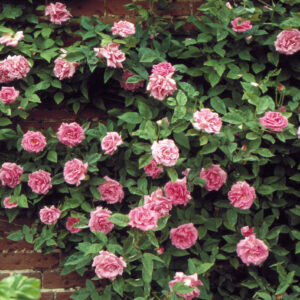
The key to any successful garden, roses included, is to know what works best for your area. Understanding weather, pests, and humidity, among other factors, plays an important role in your success. However, with the right care and maintenance, any gardener can get rose bushes to thrive.
This guide has been prepared specifically for the Arkansas region and will help you get started caring for your roses with confidence. Cantrell Gardens specializes in roses and rose care and is here to help so call or stop by and meet with one of our specialists to tailor a care plan just for you.
Daylight
On average, roses require between 6 to 8 hours of daylight. However, there are some varieties that do better than others with less light. Because this is such an important factor, we’ve written an article specifically covering how to choose the right variety and location that works best for your garden.
Water
A general rule for watering is that roses require two inches of water twice per week (frequency and amount will also depend on soil type). In the summertime, the ground dries out more quickly and the best time to water is in the morning so plants can dry during the day.
Water thoroughly and deeply. Using drip or soaker hoses to apply the water slowly and deeply to the soil at the base of the plant are preferrable to overhead sprinkling.
According to the experts at the Central Arkansas Rose Society, how frequently you water will depend upon how warm and dry the weather becomes in your area of Arkansas.
Mulch
A good layer of mulch will help retain the needed moisture and is a must in Arkansas’ summer and winter. It preserves moisture in the soil, protects the roots from heat and cold, and slows weed growth.
You should apply several inches of mulch in late spring. Two to three inches of pine bark or shredded oak leaves work well and then replenish the material as it breaks down.
In the winter, the mulch material will need to be mounded approximately 6 to 8 inches up around the trunk to protect it from freezing.
Feeding
Roses thrive on light regular feedings. You’ll want to start a feeding program when new growth begins in the spring and continue through to the first of September. Watering the plant before and after fertilizing will help to avoid burning feeder roots.
As a rule, fertilizing in spring at the first sign of new growth and then again every month until Labor Day. Application times will vary based on region and temperatures and you should visit or call a local nursery to find what works best for your location.
Pruning
Regular pruning is necessary to keep your roses in top condition. Because this is such an important part of rose husbandry, we’ve dedicated an entire article to this practice. Read our article How and When to Prune Roses for more details.
Removing Suckers
Suckers grow from the root stock at the base of the plant in grafted rose varieties. These suckers don’t produce the expected variety and should be removed. Not removing these suckers can lead to them eventually taking over the plant. They consume the plant’s energy that would otherwise go to healthy growth and bloom production.
To remove suckers:
Gently remove the soil around the sucker to find the point where the sucker grows from the root. Cut the sucker close to the stock being careful not to cut the stock itself. Last replace any soil and mulch that was removed.
Protection from Insects
The principal insects on roses in Arkansas are aphids, beetles and thrips. Insecticides control most insects, and you should follow label directions carefully. Don’t apply insecticides in hot weather above 90 degrees, as some sprays can burn the foliage. Spray rose beds after they have been watered well.
Spider mites are also a common problem. They will cause a gradual yellowing of the leaf (bottom leaves first) which finally drop off. A plant can defoliate very quickly if not treated with a miticide. Daily washing with a strong spray of water on the underside of the leaves helps to control spider mites.
Fungus Disease Control
A good fungicide program will be needed to protect from fungal disease. Two of the most common fungi are:
Blackspot is a major enemy of roses causing the leaves to turn yellow with black spots and drop off. Blackspot greatly weakens the bush and inhibits growth. Blackspot can be prevented using a good fungicide. Begin the preventive program after the first leaves appear in the spring and continue every 7 to 10 days (about 1 and a half weeks) during the growing season.
Powdery mildew is most common in early spring and early fall when the nights are cool, and the days are warm. Mildew spreads rapidly and should be controlled as soon as possible. It appears as a white mold-like covering on the new leaves and stems. A good preventative program begun with a fungicide in early spring should be effective.
ROSE TIPS FOR ROSE LOVERS
Don’t let roses intimidate you. They are just plants and respond to water, fertilizer, sun, and a little attention to disease and pest control.
Be willing to try new things. As long as it isn’t detrimental to your health or the health of the plants, give it a try. Why not?
Watch what you read. Often things which appear in local newspapers or magazines are based on what is correct for somewhere, but not necessarily your location.
Visit gardens of local rosarians and local nurseries. If you like what you see, you know that advice will work.
Don’t get discouraged. Some seasons are better or worse than others. Even the very best
Just do the best you can for your bushes. The rest is up to them and whatever nature has thrown your way.
Visit your roses daily. The best teacher is the bush itself. If it looks happy and healthy, all is well, and you feel encouraged to continue whatever good things you are doing for it. Daily visits allow you to spot problems before they get out of hand.
Don’t panic over every leaf hole, tear, discolored edge, or petal streak. Nobody’s perfect and your roses won’t be either. Be satisfied with overall good health, bloom, production, and vigor.
Throw out old wives’ tales. Many bits of rose “wisdom” have been repeated so often, they are taken for fact. The old “don’t let the leaves get wet” is probably the topper.
When it’s time to winter protect, follow the advice of your local consulting rosarians. Our climate is unique in that we don’t normally have the heavy snow cover, but have cold temperatures, freeze-thaw cycles, and wind. These will kill a rose that is unprotected.
Don’t take your roses too seriously. They are for your enjoyment! Lighten up!!! Yes, prune, feed, spray, water, pray, and prod, but take time to smell the roses.
- Excerpted from an article by A.J. Sparks, The Buckeye Rose Bulletin.
